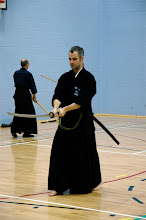So after a wonderful four days of teaching, judging,
examining, demonstrating, eating, drinking and generally putting on weight, I
am now home with a wonderful set of memories of an excellent event and meeting
some wonderful people.
During the iaido championships I made some notes about
common mistakes that people were making and we rushed through these points on
the Sunday. I was painfully conscious that providing people with information in
this format (a quick chat and a quick demo) is rarely useful as retention is
minimised so I have here listed these points to add an additional 5% chance of
them being retained…
The Easy Stuff (previously known as “Easy Sh!te” but
changed to be polite)
1.
Keito Shisei
·
Ensure the position of the sword is 45° but also
ensure the position of the hand is correct. In general some part of the left
hand should be in contact with the obi but many people position their hand on
the upper thigh.
2.
Shomen ni rei
·
This should only be 30° but very often the upper
body dips below 45°. Also make sure that the metsuke naturally drops and that
you don’t keep the eyes looking up and forwards.
3.
Mae
·
Make sure when sitting in seiza that there is no
gap between your arms and your body. You don’t need to clamp your arms tight
but there shouldn’t be sunlight coming through.
·
When making the nukitsuke ensure that the
sayabiki makes the saya position itself not only horizontally but that it is
rotated so that the saya’s hasuji is pointing towards the rear. Many people
have the saya in the same orientation (i.e. up).
·
Ochiburi should of course be as close to 45° as
possible but also make sure that the sword doesn’t elevate during the fumikae
(foot change) movement as this is very common and makes a small error even
worse.
·
Regardless of your koryu, seitei noto must start
at the centre of the body (i.e. sword and koiguchi meet at the centre) and
should start from the tsubamoto (close to the tsuba). Many people pull the
sword around the left to meet the saya.
4.
Ushiro
·
Ensure that the sword is brought at least close
to the centre of the body before sayabanare. Many people draw too far to the
front right diagonal meaning that they would miss the opponent.
5.
Ukenagashi
·
Sword must cover head with the “bo” portion of
the sword i.e. the third closest to the tsuba.
·
At the moment of the deflection stance being
made, the feet must be in the configured with the right toes kicking into the
middle of the left foot (in the Japanese “i” katakana shape). Many people are
in the Jikiden Ukenagashi position at this point.
·
The body should be completely turned to face the
shomen in this deflection position.
·
The kissaki must not finish to the right of one’s
body centreline at the end of the cut and not too low.
6.
Kesagiri
·
During the chiburi, the left hand must properly
grip the koiguchi and this must happen before the end of the cutting action.
Many people push the koiguchi down using the palm and too late.
7.
Sanpogiri
·
The final cut should show some small contrast to
the first two cuts i.e. the first two cuts are very static and grounded, the
third cut should be dynamic and the preparation should lend itself to this.
8.
Ganmenate
·
Ensure the first strike to the face is decisive
using the left hand.
·
It is very important to show the clear change of
line during the turning to the rear tsuki and especially for the final cut.
9.
Soetezuki
·
Instead of turning the right foot too early on
the final step (a historically popular mistake) many people move the right foot
to the right front diagonal thus moving them too far away from the opponent.
·
The cut must be clearly from the shoulder and
not from the belly. Many people drop their right hand too early making this cut
a flick to the belly.
·
The fingers beneath the blade still show very
easily even in this age of climate change and global economic disaster.
1.
Shihogiri
·
No wakigamae, no cigar! If wakigamae is not
clearly visible then it never happened.
·
It is important to make clearly defined cuts and
not blend one into the other especially with regards to making correct metsuke.
Look first and then cut.
. .
Sogiri
·
The “ukenagashi ni kaburi” (going through
ukenagashi to bring the sword above the head) must still properly cover the
head with the “bo”. Many people make this action bringing the right hand onto
the centreline.
·
Preparation for the sideways cut must be made
properly.
·
Don’t blend the end of the 4th cut
with the beginning of the 5th cut i.e. don’t whip the sword across
and up withouth making clear cuts and clear kaburi.
. .
Final torei
·
Don’t hook the forefinger over the tsuba. The
finger should be pressed onto the edge of the tsuba, not hooking over it.
·
The left hand must slide from around the middle
of the saya, many people slide from the top.
1.
General for taikai
·
If you get knocked out, don’t go and get changed
and go for a sleep. This is your prime opportunity to learn why you lost your
match and you can learn from some of the best sources how to improve your
performance (i.e. your peer group).




No comments:
Post a Comment